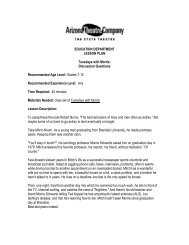CHARACTERS SYNOPSIS - Arizona Theatre Company
CHARACTERS SYNOPSIS - Arizona Theatre Company
CHARACTERS SYNOPSIS - Arizona Theatre Company
Create successful ePaper yourself
Turn your PDF publications into a flip-book with our unique Google optimized e-Paper software.
THE MARRIAGE OF FIGARO (Le Nozze di Figaro)<br />
Play Guide<br />
<strong>CHARACTERS</strong><br />
FIGARO – A barber who is a servant to the Count and<br />
engaged to Susanna. He owes Marcellina money and must<br />
marry her if he does not pay up.<br />
SUSANNA – The Countess’ witty and beautiful maid<br />
who hopes to marry Figaro.<br />
COUNT ALMAVIVA – Employer of Figaro and<br />
Susanna, a ladies’ man, who has feelings for Susanna.<br />
COUNTESS ALMAVIVA – The Count’s wife. Still in<br />
love with him, despite his philandering.<br />
CHERUBINO – The Count’s young, flirtatious page,<br />
who is in love with Barbarina and The Countess.<br />
DR. BARTOLO – The former guardian of the Countess, who<br />
holds a grudge against Figaro.<br />
Jason Hardy plays Figaro<br />
MARCELLINA – Bartolo’s housekeeper. Figaro owes her money.<br />
DON BASILIO – The music master who constantly intervenes and spreads gossip.<br />
BARBARINA – The cute, teenage daughter of Antonio who is in love with Cherubino.<br />
ANTONIO – The Count’s gardener, who is Barbarina’s father and Susanna’s uncle.<br />
<strong>SYNOPSIS</strong><br />
ACT I<br />
It is Figaro and Susanna’s wedding day. Inside the bedroom which the Count has given Figaro<br />
and Susanna as their wedding gifts, Figaro measures the dimensions for their bed while Susanna<br />
tries on a new hat. Susanna dislikes the room, claiming that it is much too close to the rooms of<br />
the Count. She reveals to Figaro that the Count has tried to seduce her. The Countess rings for<br />
Susanna and she departs. Figaro resolves that he will thwart his master’s plans.
Bartolo and Marcellina enter and plot to make good on<br />
Figaro’s word to marry Marcellina if he cannot pay a<br />
debt he owes her. Susanna and Marcellina exchange<br />
insults as Susanna hurries her out. Cherubino enters and<br />
explains to Susanna that he is in love with every other<br />
woman in the palace. The Count enters and Cherubino<br />
hides. The Count, thinking he and Susanna are alone,<br />
begins making advances to her until he is interrupted by the arrival of<br />
Don Basilio. The Count hides and Basilio gossips about the happenings in the castle. Basilio tells<br />
Susanna he thinks that Cherubino has feelings for the Countess, and upon hearing this news, the<br />
Count emerges from hiding. After a tense exchange, Cherubino is discovered. Figaro rushes into<br />
the room, carrying Susanna’s wedding veil and accompanied by villages who sing the Count’s<br />
praises. Figaro thanks the Count for renouncing the wedding night custom, and asks the Count to<br />
give Susanna the veil as a symbol of purity. The Count says he would prefer to postpone the<br />
ceremony until he can celebrate the occasion appropriately. The villages leave, and Figaro and<br />
Susanna try to persuade the Count to allow Cherubino to stay, but to no avail.<br />
Sari Gruber plays Susanna<br />
ACT II<br />
The Countess mourns her husband’s waning affections<br />
towards her. Susanna and Figaro tell the Countess that<br />
the Count is trying to seduce Susanna, and the three of<br />
them devise a plan. The Count will be given a note that<br />
says that the Countess is having an affair. While the<br />
Count is investigating, Figaro and Susanna will be<br />
married quickly. At the same time, Cherubino will be<br />
dressed as Susanna and take her place in a rendezvous<br />
with the Count in order to catch him in the act and force<br />
him to repent. Cherubino sings a love song to the<br />
Countess, and then Susanna dresses him and leaves. The<br />
Count enters, demanding an explanation for an<br />
anonymous letter. The Countess hides Cherubino in her closet Susan Nicely plays Marcellina<br />
and Susanna enters quietly while the Count and the Countess argue over what has been going on<br />
in the bedroom. The Countess says that Susanna is trying on her dress in the closet. The Count<br />
brings the Countess out with him to get tools to break down the door, locking the bedroom<br />
behind him. Susanna switches places with Cherubino, who escapes through the window. When<br />
the Countess and Count re-enter, the Countess admits that Cherubino is in the closet and the<br />
Count threatens to kill Cherubino. When Susanna emerges from hiding, the other two are
puzzled. The Count pleads forgiveness. Figaro enters and asks for an immediate wedding. The<br />
Count interrogates him about the anonymous letter. Antonio enters, complaining about his<br />
flowers, damaged by whoever jumped through the window. Susanna and the Countess try to<br />
convince the Count that Antonio is drunk again, but it is Figaro who assumes the blame, saying it<br />
was he who jumped from the window. Antonio presents a letter dropped by whoever jumped<br />
through the window. The Count believes he has caught Figaro in a lie, but Figaro correctly<br />
guesses that the letter is Cherubino’s army commission. Marcellina, Basilio, and Bartolo enter,<br />
demanding that Figaro honor his word and marry Marcellina or repay his debt. The Count<br />
postpones wedding arrangements until he has fully investigated the matter.<br />
ACT III<br />
The Count is reflecting on the current situation when Susanna enters. She says she is prepared to<br />
meet him later that evening in the garden, if he gives her the promised dowry. Susanna can pay<br />
off Marcellina with the dowry and be free to marry Figaro. Susanna leaves and meets Figaro, and<br />
assures him they will win their case. The Count overhears and becomes infuriated that his<br />
servants enjoy a happiness that he does not. He plots revenge against Figaro.<br />
Figaro, Marcellina, and Bartolo join the Count and his notary, Don Curzio, for the judgment:<br />
Figaro must marry Marcellina or repay his debt. Figaro says he cannot marry without the consent<br />
of his parents, from whom he was stolen as an infant. Marcellina realizes that Figaro is her long<br />
lost son by Bartolo. The Count and Don Curzio are upset by the happy reunion. Susanna enters<br />
with the money to pay Figaro’s debt, but upon seeing<br />
Figaro embracing Marcellina, she becomes upset.<br />
Marcellina and Figaro explain their reunion, and celebrate<br />
the rediscovery of a long-lost son while the Count and<br />
Don Curzio curse the events of the trial.<br />
Marion Pop plays Count Almaviva<br />
Meanwhile, the Countess is still mourning the loss of her<br />
husband’s affections. Susanna enters, and after she<br />
informs her of the verdict of Figaro’s case, they compose<br />
a letter to the Count to meet her in the pine grove. They<br />
seal the letter with a pin.<br />
Barbarina and Cherubino in disguise arrive with flowers for<br />
the Countess. The Count enters with Antonio, who reveals that Cherubino was the one who<br />
jumped out of the balcony window and on to the flower bed. Barbarina pleads with the Count not<br />
to punish Cherubino and let her marry him. The Count agrees.
Figaro enters and the wedding celebrations begin. During the wedding dance, Marcellina,<br />
Bartolo, Susanna, and Figaro are presented to the Count and Countess. Susanna secretly passes<br />
the letter to the Count. Figaro notices the pin and believe it is another indication of the Count’s<br />
affairs.<br />
ACT IV<br />
Figaro and Marcellina arrive in the garden that evening. They see Barbarina, who is searching<br />
for the pin that the Count asked her to return to Susanna. Figaro believes Susanna is unfaithful<br />
and Marcellina leaves to warn Susanna of Figaro’s discovery. He tells Basilio and Bartolo to<br />
help him surprise the loves when he gives the signal. Figaro considers the betraying nature of<br />
women.<br />
Susanna and The Countess enter. The two women have switched clothing. Susanna, disguised as<br />
the Countess, calls for her lover to come, knowingly upsetting Figaro. Mayhem ensues.<br />
Cherubino tries to kiss the Countess (dressed as Susanna). The Count and Figaro shoo him away.<br />
The Count woos his wife dressed as Susanna. Figaro tells Susanna, whom he believes is the<br />
Countess, what is going on. He recognizes Susanna’s voice and still continues to woo the<br />
“Countess”. After Susanna chides him for his trick, the two are reconciled. The Count calls in<br />
witnesses as he comes upon Figaro who he believes is his wife. The entire garden party appears.<br />
The Countess reveals herself and the Count requests forgiveness as he realizes he has been<br />
caught trying to woo Susanna. The Countess lovingly pardons him. Everybody celebrates love<br />
and what a crazy day it has been!<br />
MOZART BIOGRAPHY<br />
Wolfgang Amadeus Mozart was born in Salzburg,<br />
Austria on January 27, 1756. His father, Leopold Mozart,<br />
was the vice Kapellmeister (assistant choir director) to the<br />
Archbishop of Salzburg and one of Europe’s leading<br />
violinists. He had one older sister, named Maria Anna<br />
“Nannerl” Mozart. Leopold tutored Maria Anna on the<br />
violin and the clavier (a precursor to the harpsichord).<br />
Mozart, three years old at the time, would spend hours<br />
picking out tunes on Nannerl’s clavier. By age four,
Leopold began tutoring Mozart was well. Mozart wrote his first compositions when he was five<br />
years old. Though the pieces were relatively simple, they still displayed a strong grasp of music<br />
compositional form and structure. He also had his first public performance with his sister at age<br />
five, before a court in Munich. Mozart’s virtuosity as a performer was so astounding that his<br />
father quit his job, devoted all his time to teaching Mozart, and toured with him all over Europe.<br />
Mozart played for Louis XV in Versailles and George III in London, and he met many famous<br />
musicians during his travels. When Mozart was eight years old, he wrote his first three<br />
symphonies. The next year, his sonatas were being published in Paris. During these travels,<br />
Mozart met Johann Christian Bach, son of Johann Sebastian Bach. The friendship would last<br />
them the rest of their lives.<br />
The life of young Mozart was one of travel, composing, and performing. His father was a<br />
loving but exacting taskmaster. His family’s travels exposed him to diverse operatic genres,<br />
particularly Italian opera and the opera comique in Paris. By age 11, he had written his first<br />
opera, Apollo et Hyacinthus (Apollo and Hyacinth), and at age 14 his opera Mitridate was<br />
performed in Milan. Mozart possessed the unique ability to<br />
vary the moods of his music within the conventional forms of<br />
the period.<br />
When Mozart was sixteen years old, he was appointed<br />
concertmaster in the orchestra of Archbishop of Salzburg. This<br />
meant he now received a salary. He worked for the Archbishop<br />
while also composing music for many private patrons, which<br />
was an important source of income for musicians and<br />
composers at the time. In 1774, Mozart was invited to<br />
compose an opera buffa (comic opera) for the Munich opera<br />
season. During this time, operas were written specifically for<br />
singers who were to perform them. This means the composer had to work closely with the<br />
performers and understand the ability of each singer.<br />
Mozart developed from composing conventional music to writing works of much greater<br />
individuality. He longed to compose operas, but there was a limited demand for them. His low<br />
salary in the concertmaster position persuaded him to want to tour once more. In 1777, Mozart<br />
received permission from the Archbishop of Salzburg to be released from his appointment to go<br />
on tour. Mozart toured with his mother, hoping to find a more lucrative court position. After<br />
staying in Mannheim for several months, the two traveled to Paris. Mozart was not<br />
professionally successful in Paris, and to make matters more difficult, his mother died in Paris<br />
during their tour. Mozart returned to Salzburg in 1779 and was appointed as court organist and<br />
concertmaster to the Archbishop of Salzburg. Just two years later, he resigned from his position<br />
due to increasing tension and disagreements between Mozart and the Archbishop. Mozart moved<br />
to Vienna in 1781. He decided to make his living as a freelance performer and composer. This<br />
was a highly unusual step for a musician to take at the time. His opera Die Entfuhrung aus dem
Serail (The Abduction from the Seraglio) premiered in Vienna in July 1782 and was met with<br />
great success.<br />
Mozart married Constanze Weber in 1782. Mozart’s father and sister were opposed to his<br />
marriage to Constanze because she was part of a lower social class. As a result, they never<br />
developed a good relationship with Constanze. Mozart supported his family by performing in<br />
public and private, teaching, and composing (mainly piano concertos). This was a period of<br />
financial success, and the Mozarts spent lavishly. Mozart and Constanze had six children over<br />
their nine years of marriage. Only two children survived beyond childhood: Karl Thomas, born<br />
in 1784, and Franz Xaver Wolfgang, born four months before his father’s death.<br />
The citizens of Vienna did not hold the same regard for Mozart as an adult as was shown<br />
to him as a child. The adult Mozart was one of several successful musicians and composers, and<br />
he no longer had the special status of child prodigy. Mozart’s mature musical style was not what<br />
the citizens of Vienna were used to. Mozart never received the court appointment he wanted, but<br />
he continued to be a prolific composer and explored new approaches in his works. He<br />
collaborated with librettist Lorenzo da Ponte and composed three great operas: Le Nozze di<br />
Figaro (1786), Don Giovanni (1787), and Cosi fan tutte (1790). In these operas, Mozart ignored<br />
the regular opera standard and created truly innovative work. He created full ranges of emotions<br />
with the music, using major and minor keys to give the impression of opposite reactions and<br />
feelings. Mozart experimented and tested combinations outside of popular standards of the<br />
period.<br />
By 1787, Mozart’s success was truly slipping. His compositions were not being accepted<br />
by Viennese society; they considered his music too difficult and unusual. The emperor himself<br />
told Mozart there were “too many notes” in his compositions. People did not appreciate his<br />
radical music because they did not understand Mozart’s complex and extraordinary music.<br />
Mozart was incorporating many musical elements and styles from different countries into his<br />
works.<br />
Mozart’s behavior was becoming more erratic, and his financial debt was increasing.<br />
Teaching was no longer a large source of income for him. Fewer and fewer patrons were<br />
commissioning work from him. Ironically, the works he was composing at this time are now<br />
considered to be his greatest. He died on December 5, 1791, just prior to his thirty-sixth birthday.<br />
Mozart’s personality has been described as frivolous, eccentric, restless, and mercurial.<br />
While he might have not been the most pleasant person to be around, one cannot deny the<br />
creative genius of Mozart. In less than 36 years, he revolutionized Western music.
LIBRETTIST<br />
Lorenzo Da Ponte wrote the libretto of The Marriage of Figaro, meaning he wrote the<br />
words to Mozart’s music. Da Ponte was born on March 10, 1749 in the Jewish ghetto of Ceneda,<br />
Italy. Da Ponte studied at seminary to become a priest. This is<br />
where he was first introduced to Italian poets, starting his lifelong<br />
love of this genre. Though ordained as a priest at age 24, the<br />
priest lifestyle did not fit Da Ponte, as he was infamous for<br />
gambling and affairs with married women. Da Ponte moved from<br />
Venice to Vienna, the true cultural center at that time. The<br />
Emperor of Vienna was known for his tolerance of Jewish people,<br />
something the rest of Europe did not share, and so Da Ponte felt<br />
satisfied knowing that his origins would not be held against him.<br />
In 1783, Da Ponte was appointed theatre-poet to the Court Opera<br />
in Vienna, which was then devoted to the production of Italian comic opera. It was there that he<br />
met Mozart, and the three collaborated on Le Nozze di Figaro, Cosi fan tutte, and Don Giovanni.<br />
In 1792, Da Ponte moved to London to work with an Italian opera company. It was there<br />
he met Nancy Grahl, whom he dated the rest of his life. In 1805, he and Nancy departed for the<br />
United States, where Da Ponte became a merchant, a bookseller, and a professor of Italian at<br />
Columbia University. Much of his time in the United States was devoted to promoting Italian<br />
opera.<br />
OPERA DEFINITIONS<br />
Aria – An aria is a solo where one character expresses his or her emotional state for several<br />
minutes. While the words to an aria are important, they are sparse and the singer usually repeats<br />
words multiple times.<br />
Aside – A comment from an actor to the audience that the other characters cannot hear.<br />
Bel Canto – “beautiful singing” in Italian. In opera, it is an Italian style of singing emphasizing tone,<br />
phrasing, coloratura passages, and technique.<br />
Cabaletta – Second, faster part of a two-part aria.<br />
Cadenza – a passage of singing, often at the end of an aria, that shows off the singer’s vocal abilities.<br />
Cavatina – The opening, slow section of a two-part aria.<br />
Coloratura – elaborate ornamentation of music written for a singer using many fast notes and trills
Ensemble – Ensemble feature lots of characters singing at once. Mozart uses the ensemble to<br />
express the emotions of several characters simultaneously. He would show his characters’ moods<br />
and alliances through the different music of each group of characters.<br />
Leimotif - short, repeated musical phrases associated with a particular person, place, or idea<br />
Libretto – the complete text of the opera<br />
Overture – An orchestral introduction to the opera.<br />
Pastoral – A pastoral is a drama about the natural world and people who live close to nature.<br />
Recitative – A recitative is as close as opera gets to spoken dialogue; it’s the only time the music<br />
is not as important as the words. Recitatives are accompanied by harpsichord, which makes it<br />
easier to understand the text. The words go by very quickly, and often on just a few notes.<br />
Scena – A dramatic episode within the opera which consists of a variety of numbers—could include a<br />
recitative, a cavatina, and a cabaletta—with a common theme.<br />
Sitzprobe – “Seated rehearsal” in German. The first rehearsal of the singers with the orchestra and no<br />
acting.<br />
Tessitura – The area of vocal range within which the major part is sung.<br />
Trill – a deliberate, very quick alternation between two notes. Not the same as a vibrato, which is more<br />
naturally occurring.<br />
Tremolo – The quick, continuous reiteration of a pitch.<br />
Verismo – a realistic style of opera that started in Italy at the end of the 19 th century.<br />
Vibrato – A natural wavering of frequency (pitch) while singing a note. Not as deliberate as a trill.<br />
SOURCES:<br />
http://www.its.caltech.edu/~tan/Mozartreq/main.html<br />
http://www.chicagooperatheater.org/wolfgang-amadeus-mozart-biography/<br />
http://www.wamozartfan.com/bio.html
http://www.bbc.co.uk/music/artists/b972f589-fb0e-474e-b64a-803b0364fa75<br />
http://www.meetthemusicians.us/wolfgang-amadeus-mozart.asp<br />
http://www.lehrerweb.at/materials/gs/faecheruebergreifendes/vbs/mozart.pdf<br />
http://www.guardian.co.uk/music/2012/aug/14/glyndebourne-2012-the-marriage-of-figaromusical-guide<br />
http://www.manitobaopera.mb.ca/learn/documents/MarriageofFigaroStudyGuidefinal.pdf<br />
http://www.kcopera.org/our_season/docs/guide_figaro.pdf<br />
http://www.madisonopera.org/uploads/PDFs/FIGARO_MatineeGuide_MO.pdf<br />
http://www.metoperafamily.org/metopera/history/stories/synopsis.aspx?customid=13


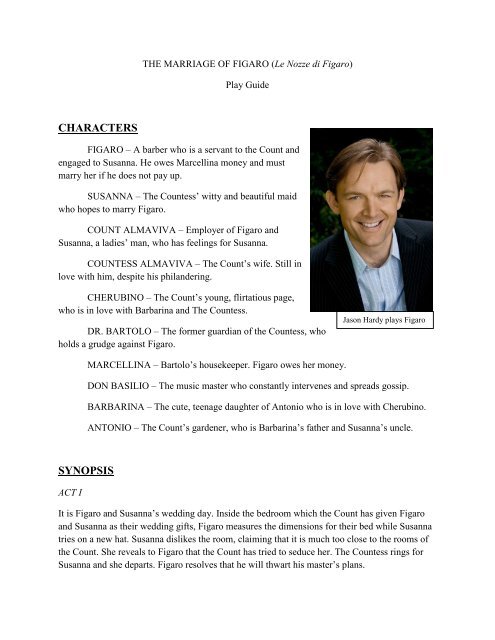
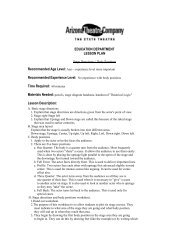



![Play Guide [356k PDF] - Arizona Theatre Company](https://img.yumpu.com/46218320/1/190x245/play-guide-356k-pdf-arizona-theatre-company.jpg?quality=85)
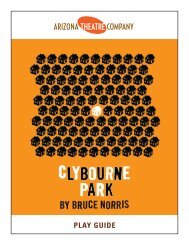
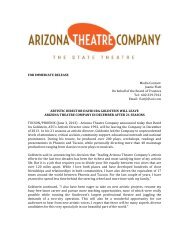
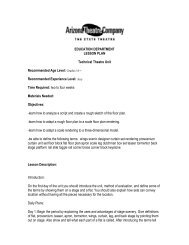
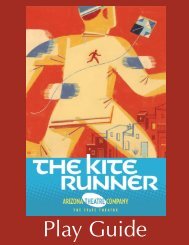
![[title of show] Arizona Theatre Company Play Guide 1](https://img.yumpu.com/24482689/1/190x245/title-of-show-arizona-theatre-company-play-guide-1.jpg?quality=85)
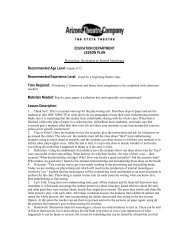
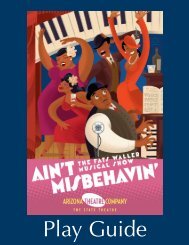
![Play Guide [1.2MB PDF] - Arizona Theatre Company](https://img.yumpu.com/11952176/1/190x245/play-guide-12mb-pdf-arizona-theatre-company.jpg?quality=85)
